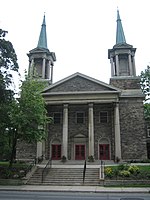Beltline Trail
Linear parksParks in TorontoRail trails in OntarioTransport in Toronto

The Beltline Trail is a 9-kilometre (5.6 mi)-long cycling and walking rail trail in Toronto, Ontario, Canada. It consists of three sections, the York Beltline Trail west of Allen Road, the Kay Gardner Beltline Park from the Allen to Mount Pleasant Road, and the Ravine Beltline Trail south of Mount Pleasant Cemetery through the Moore Park Ravine. Built on the former right-of-way of the Toronto Belt Line Railway, the linear park passes through the neighbourhoods of Rosedale, Moore Park, Forest Hill, Chaplin Estates, and Fairbank.
Excerpt from the Wikipedia article Beltline Trail (License: CC BY-SA 3.0, Authors, Images).Beltline Trail
Kay Gardiner Beltline Trail, Old Toronto
Geographical coordinates (GPS) Address Nearby Places Show on map
Geographical coordinates (GPS)
| Latitude | Longitude |
|---|---|
| N 43.695998 ° | E -79.398397 ° |
Address
Kay Gardiner Beltline Trail
Kay Gardiner Beltline Trail
M5P 1A2 Old Toronto
Ontario, Canada
Open on Google Maps








